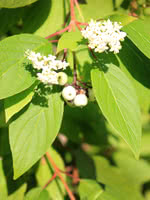Mon-Fri 9am - 5pm Mountain time
Yellow Twig Dogwood vs Grouseberry
Cornus sericea flaviramea
Vaccinium scoparium
CUSTOM GROW
CUSTOM GROW
Yellow Twig Dogwood is a small deciduous shrub with attractive, bright yellow bark.
It features delicate white, star-shaped flowers and white fruit. It is often used as a screen, and its wide-spreading roots help stabilize areas experiencing soil erosion.
Yellow Twig Dogwood complements Red Osier Dogwood, and it is a great filler to add winter color to shrub and flower gardens.
Grouseberry is a native, low-growing deciduous shrub known for its edible red berries. In early summer, it produces small, urn-shaped flowers ranging from white to pink that attract bees and other pollinators. The berries provide an important food source for many types of wildlife, including game birds such as grouse, which gives the plant its common name. People can also enjoy the berries fresh or in baked goods, though they can be difficult to harvest in large quantities.
Spreading by rhizomes, Grouseberry forms dense, broom-like mats that help stabilize soil and prevent erosion, while also providing cover for ground-nesting wildlife. It is commonly found beneath conifers in open forests, subalpine meadows, and occasionally on rocky slopes in mountainous regions. It is well-suited for naturalization, ecological restoration, and soil stabilization projects.
Yellow Twig Dogwood Quick Facts
Grouseberry Quick Facts
In row spacing: 0.9 m (3 ft)

